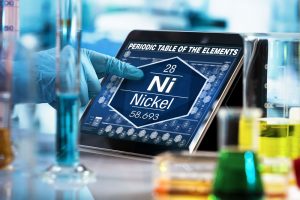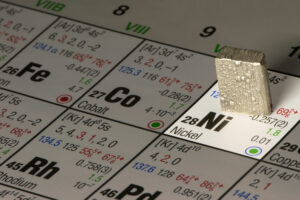Properties and Applications
Nickel is a silver-colored metal that is referred to as a heavy metal due to its high density. It is more resistant to corrosion than other metals and is therefore used in many alloys to improve this property. It is also used extensively in technology as a surface coating; nickel is normally applied by electroplating. Nickel-cobalt-manganese-lithium mixed oxides are used in batteries (accumulators, rechargeable batteries).
Finely dispersed nickel can be self-igniting (pyrophoric), which is why it must be stored as nanoparticles under inert gas.
Nickel in everyday applications
Nickel is found in the form of alloys in coins (a "nickel"), eyeglasses and fashion jewelry (e.g. formerly: nickel glasses or wristwatches, today reduced due to allergy risk), magnets (alnico), guitar strings, microphone capsules, fittings coatings, for the green coloring of glass, and in ceramic pigments.
In the light of the energy transition, the most discussed application of nickel at the moment is probably in the cathode materials of rechargeable batteries. In current research work, nickel and other metals are hidden in abbreviations such as NMC 6:2:2, in the example it is a mixed oxide of lithium, nickel, manganese and cobalt, the numbers indicate the quantity ratios of the metals (without lithium), i.e. NMC 622 means that there are 2 atoms of manganese and 2 atoms of cobalt for every 6 atoms of nickel. Common ratios are, e.g:
- NMC111: LiNi1/3Mn1/3Co1/3O2
- NMC622: LiNi0.6Mn0.2Co0.2O2
- NMC811: LiNi0.8Mn0.1Co0.1O2
Class 1 nickel, which has a purity of more than 99%, is usually used for battery materials . More recent developments have centered on higher nickel contents, e.g. NMC811 in the cathodes, in order to reduce dependence on cobalt.
Nickel is mainly used to improve the quality of steel. V2A stainless steel, which is widely used around the world, contains 8% nickel. V4A steel with a nickel content of 11% is better known in everyday life under the brand names Cromargan or Nirosta. In cutlery labelled with the trade name "nickel silver", up to a quarter of the weight is nickel. It is used here to maintain the luster of the new cutlery over a long period of time because the nickel prevents surface corrosion (tarnishing). Surgery instruments can also be made of nickel-alloyed steel. Nickel plating is used to protect everyday objects made of steel and other metals from corrosion. This is done by electroplating, an electrochemical process.
Constantan, a copper-nickel alloy, is used for electrical devices that require particularly precise resistances that also need to remain constant over a wide temperature range.
Nickel in the industry
Steels containing nickel (see above) and nickel-plated appliances, fittings and utensils are particularly common in laboratories and in the chemical industry (nickel spatulas). The increased corrosion resistance of nickel is utilized here. Monel metal is another nickel alloy made from nickel, copper and iron, whose special resistance to fluorine gas is used in the manufacture of gas cylinders.
Nickel-based superalloys are used for highly stressed machine parts, which can also withstand the loads in aircraft turbines and gas turbines.
Nickel is used in a large number of catalytic processes and is one of the most important catalyst materials in the chemical industry . Raney nickel is a nickel-aluminum alloy that is used for the catalytic hydrogenation of organic compounds with hydrogen. A practical application of Raney nickel and other nickel-based catalytic processes, which also reaches the household dining table, is the hydrogenation of unsaturated fatty acids in vegetable oils during margarine production, known as fat hardening. This is necessary because although vegetable oils are produced relatively cheaply and with a low CO2 footprint, they are not suitable as a butter substitute due to their liquid form. The challenge in fat hardening is to produce as few trans fatty acids as possible, which are produced as a by-product. They are considered to be a contributory cause of cardiovascular disease – in contrast to the cis fatty acids that occur naturally in vegetable fats.
Nickel compounds, often together with other components, are the focus of research work on hydrogen storage materials, including metal hydrides (for example as a nano-catalyst with zinc boranate (Zn(BH4)2) or magnesium hydride (MgH2) or as a nickel-containing hydrogen compound nickel aluminum hydride (NiAlH4) .
Natural Occurence of Nickel
Nickel ores, i.e. mineral deposits of nickel that are industrially exploited, can be found in Indonesia (33.6% of global production in 2019), the Philippines (12.7%), New Caledonia (8.3%), Canada (7.4%), Australia (6.3%) and other countries . It is mined there, often in open-cast mines, which causes massive damage to the landscape. If nickel is extracted by underground mining, the impact on the landscape is less, but the overburden (i.e. the rock that is produced when the nickel ore is excavated, but which itself contains no or too little nickel to be processed further) must be accommodated.
The most important minerals with a nickel content worth mining are pentlandite (also known as nickel magnetic pyrites) and various silicate minerals with different nickel contents such as garnierite, népouite, nontronite and nickel-bearing goethite. In addition to nickel, these minerals also contain other elements such as iron .
In addition to the deposits of nickel that are used to produce the metal, nickel is also present in traces in plants and microorganisms. Here nickel plays an important role in enzymes (e.g. in ureases, Co-F430). In mammals, however, no evidence of nickel-containing enzymes has been found to date .
Production of Nickel
Nickel metal is obtained from ores. In addition to nickel, these often contain iron and copper. During nickel extraction, iron is removed as an unwanted component in the form of iron oxide or iron silicate slag using metallurgical processes. This produces a copper and nickel containing intermediate. In contrast to the formerly removed unwanted iron, copper is not thrown away due to its relatively high value. Instead, the two metals are separated from each other in a further high-temperature process and processed further, producing crude nickel. It is used directly in steel production. The crude nickel is then refined by electrolysis into pure nickel with a standard purity of > 99.8%, which is already suitable for many applications, e.g. batteries. If even purer nickel is required, the pure nickel can be refined to ultra-pure nickel using the Mond process. It then consists of more than 99.99% nickel.
To produce nickel nanoparticles, nickel compounds of oxidation state +2 are usually reduced in solution to nickel metal in a carefully controlled process. To prevent the nickel nanoparticles from forming larger aggregates again immediately after their formation, a surfactant, i.e. a type of soap, is added, which prevents the nanoparticles from forming aggregates by attaching to one another .





